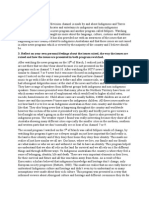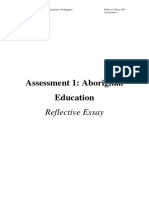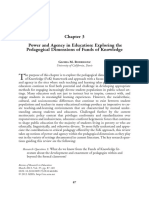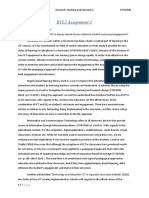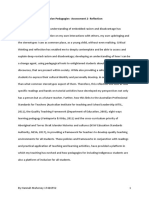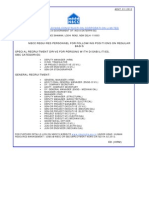Advocacy PDF
Advocacy PDF
Uploaded by
ryemasonCopyright:
Available Formats
Advocacy PDF
Advocacy PDF
Uploaded by
ryemasonOriginal Description:
Original Title
Copyright
Available Formats
Share this document
Did you find this document useful?
Is this content inappropriate?
Copyright:
Available Formats
Advocacy PDF
Advocacy PDF
Uploaded by
ryemasonCopyright:
Available Formats
Children have a right to what is just and good in our society.
These rights include: the right to be safe the right to protection from harm the right to be heard and believed and the right to protection from discrimination
In childrens services, knowledge or information about childrens rights can be found in our national and state legislation, in the national quality assurance systems, in the Early Childhood Australia (ECA) Code of Ethics and United Nations Convention on the Rights of the Child.
Advocating for children
Ball (2001) uses the Concise Macquarie Dictionary definition for advocacy. She states the meaning as: Pleading in favour of; supporting or urging by argument; recommending publicly; representing of interests. Ball then defines an advocate from the same source as one who defends, vindicates or espouses a cause by argument; an upholder; a defender (p.15). You will be taking a leadership role in your service. It is therefore expected that you will share your vision for children with others and, when appropriate, take action to ensure that childrens rights are upheld. Hughes & MacNaughton (1999, pp. 275-276) state that: Commercial advertisers use very specific techniques of persuasion. They suggest that you: Locate your target audience. Present a window on the issues of childrens rights, and to look through so that the audience see themselves as already implicitly committed to the issue. Shape your message to the audience taking account of their different interests and experiences.
Possessing the commitment, confidence, strength and determination to stand up for your beliefs is an important aspect of your developing professionalism. Vander Ven (1988) considers that care and education professionals begin to develop their potential for advocacy in the informed stage of the professionalism continuum. However, she believes that those in the complex stage have the greatest potential for standing up and speaking out on behalf
of what is best for children, their families and the profession. What do you think? Are you ready to make a stance? Children require strong adults who will speak out for them, and families require support in ensuring that their children receive the highest quality care possible. To advocate effectively on their behalf, early childhood professionals need to unite as a powerful force in support of excellence in early childhood programs and a shared respect for and valuing of young children. Advocacy is about speaking out, acting, and writing to promote and defend the rights, needs and interests of people who are in some way disadvantaged. Gibbs, 2003, p.6. You may be thinking that this all seems a little hard, that you dont possess the skills to speak publicly on behalf of children and their families, or that your contribution would be too small to matter. Remember - ripples can become waves! Being an advocate in childrens services requires strength and determination. But, even the smallest of contributions is better than none at all An advertorial document known as the Code of Ethics is a set of guidelines for professional behaviour that protects the interests of young children, parents, early childhood workers, employers and the community. The shared values that underpin the ECA Code of Ethics include: the uniqueness of each individual child, family member and colleague; respect for positions and viewpoints that differ from your own; and basing practice on the best current knowledge. (Stonehouse, 1991 cited in Sebastian-Nickell, 1997, p. 51) Although the Code of Ethics will not provide easy answers or prescriptive solutions, it does provide guidelines for advocacy, professional behaviour and some assistance with the resolution of dilemmas. Advocacy refers to supporting the cause of another and, as a care and education professional; you have an ethical responsibility to represent the best interests of children, families, colleagues, and the profession. The United Nations Convention on the Rights of the Child emphasises independence and self-actualisation as the goals of childhood; a move from a protection and nurturance focus to one of self-determination, personhood and the right of a child to dignity and respect. (Sebastian-Nickell & Milne, 1997, p. 264).
And sets standards of care for all children. If we apply the Convention to our workplace, we need to acknowledge it in the philosophy and policies we adopt for children in order to achieve the best interests of the child. In practice, we need to demonstrate respect for children as individuals and respond to all children according to their economic, social and cultural needs. (Greenwood, 1993, p. 12) Parents and colleagues also have rights and, as a care and education professional, it is your responsibility to ensure that your relationship with them is one of respect, open communication, collaboration and shared decision-making. The United Nations Convention on the Rights of the Child underpins all legislation in the signatory countries. Since children are dependent upon adults to ensure their safety and well being, it is vital that rules and regulations are established to protect them from harm. According to the United Nations Convention on the Rights of the Child: The child shall enjoy special protection and shall be given opportunities by law and other means to enable him to develop physically, mentally, manually, spiritually, and socially in a healthy and normal manner. (cited in Faragher & MacNaughton, 1998, p.205)
Advocating parents and the community
One of your roles as a professional is that of an advocate for children, to parents and the community in the dissemination of information on a range of issues. Knowing how to obtain this information and present it in a manner accessible to a diverse audience will reflect your professionalism and promote positive relationships between your service and its community. Children and their families are part of the local communities in which they live, and care and education professionals are increasingly expected to recognise this by: working in partnership with parents to build relevant and responsive programs for the children in their care creating links with their centres local communities so that their programs reflect the strengths, values and issues within them, and linking with parents and their wider community to advocate on behalf of children. (Hughes & McNaughton, 1999, p.220)
This expectation is reflected in the ECA Code of Ethics (Stonehouse, 1998, p.8) which guides the care and education professional to: provide programs which are responsive to community needs, support the development and implementation of laws and policies that promote the well- being of children and families and that are responsive to community needs promote cooperation among all agencies and professions working in the best interests of young children and families, and promote childrens interests through community education and advocacy.
Arthur et al (1996, p. 23) suggest a number of strategies that can be used to ensure that your communications with families are two-way: daily communications, newsletters, information booklets, noticeboards, etc providing resource books, articles and magazines of relevance to parent/community interest providing information about political and financial trends which influence childrens services, and on avenues of advocacy and opportunities to lobby for change establishing a meeting room or a space for family members to talk and share information providing a noticeboard that can be used by families to share information, recognising that families are valuable sources of information for each other organising evening workshops or presentations on issues of relevance.
Once you have established open, honest and trusting communications with families, you have opened the door to a valuable opportunity to be able to educate and empower them about the needs and rights of children and young people, in your role as an advocate for children and young people.
Advocating for children about specific rights or needs
In many situations children are powerless to greatly affect their circumstances. They are vulnerable to the many people and situations that they encounter, mainly through their family members, carers and teachers. Because children are unlikely to be able to represent themselves in any public forum, it is the advocates duty to do this on their behalf. An early childhood professional is required to know and understand the needs of children to recognise when these needs are not being met during the normal course of their lives. Some children have needs which, if not met, can result in developmental delay, social dysfunction or illness.
Collecting and presenting information
Once you have identified an issue that does not uphold a childs/childrens rights or is not in their best interests, the next step is to collect comprehensive background information and evidence and to document it appropriately. The documentation must be stored safely and securely so that it does not fall into inappropriate hands. Information about a specific issue can be gathered from observations and/or discussions with one or more of the following. Of course, the issue will determine the sources used. Service documents e.g. profiles of children Families Siblings Other children Carers Observation Previous service that the child may have attended Support agencies who may work with the child
The first type of information that you need to collect will be about best practice i.e. how things should be done. Information about best practice needs to be based on up-to-date and accurate knowledge of the topic. Reading the latest professional journals, accessing the internet and seeking information from recognised authorities are some of the ways that you can achieve this. The second type is about what is actually happening? i.e. current practices in the service. For example, if you were concerned about the number of obese children attending your OSHC
service, then you would need information about appropriate health and nutritional standards and policies at your service. Collecting information about what is actually happening requires very careful consideration. Above all, you need to remember that the staff and/or parents involved have access to these files under Freedom of Information Act Therefore, you should be very careful to record only that information that is relevant to the issue. You also need to be aware that you may be required to collect specific information to meet legislative and quality assurance requirements. You may choose to document in any number of ways the information that you collected. Reports, photographs, and forms specifically designed for your service could form part of your documentation. Regardless of the method of documentation, the information that it contains must be relevant and accurate. Each contribution must be dated and the full names of those involved included. Documentation must be completed during, or as soon as possible after, the event. Documentation must be stored in a way that ensures it can only be accessed by specified staff. The way information is presented will, of course, vary according to the audience, purpose and issue. When advocating for childrens rights, you might need to be aware that government departments often have standardised forms to ensure that they receive information that meets their requirements for consistency, accountability and legality.
The way in which you present information so that it is accessible to a diverse audience is part of being an advocate. To assist you with this, Hughes & McNaughton, (1999, p.13) suggest that care and education professionals adopt the PEG approach in attempting to meet the information needs of others: Professional Equitable Goal-oriented Professional communication ensures that you gain respect for your professionalism, particularly if the information that you present is based on the best available current knowledge. It is important, however, that you do not confuse professional communication with jargon. Using jargon to meet the information needs of others can quickly create barriers and should be avoided completely. Equitable communication will ensure that you meet the information needs of others through relationships which are fair, respectful, appropriate and relevant to the full range of cultural
and social groups. For instance, in meeting the information needs of others, are you inclusive of all people regardless of race, culture, gender, ability, age, religion or language? By becoming goal-oriented in your efforts to meet the information needs of others you will avoid the possibility of misinterpretation. You should ask yourself: Who is my intended audience? What exactly is the information need or issue I am trying to address? How will I present the information? What should be included in the information? What is the purpose of the information - is it to entertain, inform, educate or recruit my intended audience?
Approaches to advocacy
Hughes and MacNaughton (1999, pp. 276-278) define advocacy strategies as either explicit advocacy, or implicit advocacy and then recommend an impersonal or a personal approach to convey the intended message. Sometimes raising an issue is not enough. An assertive advocate must be persistent and must pursue their cause until a positive result (not always the result that they initially were hoping for) is gained for the benefit of the child or children in general. Assertiveness involves being direct and honest in a polite and considerate way. An assertive person in a work team presents their own point of view and the view of others with fairness and reasonableness. They are usually good communicators. They look people in the eye, are relaxed and open in their body language, and have a high degree of confidence. (Elder, 1994, p.65). Assertiveness is not to be confused with aggressiveness. There is no place for aggressiveness in childrens services. Sometimes non-assertive people are so frustrated by never being taken notice of that they become aggressive or some people have developed the practice of bullying to get their own way. Neither are effective means of advocacy. A childs welfare is a high stake so it is important to learn the communication techniques required to allow your message to be understood and to motivate action.
Application
To develop a campaign that will advocate for the rights and needs of child/children within your organisation/local community.Gibbs (2003, pp. 27-28) provides the following steps in planning an advocacy campaign.
Identify the issue Find out about the issue Set goals Plan your action and choose strategies Implement Review
Children are sometimes powerless to change their circumstances. Children require strong adults who will speak out for them, and families require support in ensuring that their children receive the highest care possible. Assertiveness and persistence are often required to ensure that your advocacy message is heard and to motivate others into action.
You might also like
- Edfd227 Assignment 1Document5 pagesEdfd227 Assignment 1api-522586054No ratings yet
- Mildred PartenDocument15 pagesMildred PartenryemasonNo ratings yet
- Part A: Scenario 1: RileyDocument10 pagesPart A: Scenario 1: Rileythunguyenhoang0303No ratings yet
- COT-LESSON-PLAN-MATHEMATICS Quarter 2Document3 pagesCOT-LESSON-PLAN-MATHEMATICS Quarter 2Lady Chu100% (1)
- Position Paper - Inclusive PracticeDocument5 pagesPosition Paper - Inclusive Practiceapi-339522628No ratings yet
- Edfd227 Parenerships EssayDocument2 pagesEdfd227 Parenerships Essayapi-254025125No ratings yet
- Assignment 2 Case StudyDocument6 pagesAssignment 2 Case Studyapi-427319867No ratings yet
- Edab Ass 1Document2 pagesEdab Ass 1api-298379083No ratings yet
- Edfx 267 Community EngagementDocument8 pagesEdfx 267 Community Engagementapi-319348099No ratings yet
- Edfd227 Assignment 3Document8 pagesEdfd227 Assignment 3api-358028771100% (1)
- Assignment 1: Aboriginal Education (Critically Reflective Essay)Document11 pagesAssignment 1: Aboriginal Education (Critically Reflective Essay)api-355889713No ratings yet
- Luke Ranieri 17698506 Report Into Why Young People Misbehave in SchoolDocument8 pagesLuke Ranieri 17698506 Report Into Why Young People Misbehave in Schoolapi-486580157No ratings yet
- Edph Assessment 2 Unit of WorkDocument11 pagesEdph Assessment 2 Unit of Workapi-260503527No ratings yet
- DTL Assessment 1 - FinalDocument8 pagesDTL Assessment 1 - Finalapi-505912741No ratings yet
- George Dickie Defining Art PDFDocument5 pagesGeorge Dickie Defining Art PDFOrganza Air LuckNo ratings yet
- Empowering Parents & Teachers: How Parents and Teachers Can Develop Collaborative PartnershipsFrom EverandEmpowering Parents & Teachers: How Parents and Teachers Can Develop Collaborative PartnershipsNo ratings yet
- Creative Centers and Homes: Infant Care, Planning and Developing Family Day Care, and Approaches to Designing and Creating the Child's EnvironmentFrom EverandCreative Centers and Homes: Infant Care, Planning and Developing Family Day Care, and Approaches to Designing and Creating the Child's EnvironmentNo ratings yet
- The Essentials: Providing High-Quality Family Child CareFrom EverandThe Essentials: Providing High-Quality Family Child CareNo ratings yet
- Management and Leadership ReportDocument9 pagesManagement and Leadership Reportapi-360716367No ratings yet
- Edfd462 Assignment 1 FinalDocument20 pagesEdfd462 Assignment 1 Finalapi-239589333No ratings yet
- PLP For WebsiteDocument13 pagesPLP For Websiteapi-512783934No ratings yet
- Edfd452 At2 Critical Reflections Elsie StoelDocument6 pagesEdfd452 At2 Critical Reflections Elsie Stoelapi-319869838No ratings yet
- EDFD462 Personal Professional Learning PlanDocument5 pagesEDFD462 Personal Professional Learning PlanClaudia YoussefNo ratings yet
- Edma360 - Assignment 1Document3 pagesEdma360 - Assignment 1api-319280742No ratings yet
- Case StudyDocument6 pagesCase Studyapi-303293059No ratings yet
- Module 5 Diverse LearnersDocument5 pagesModule 5 Diverse Learnersapi-319072082No ratings yet
- Assessment Two EdfdDocument8 pagesAssessment Two Edfdapi-265573453No ratings yet
- Edfd452 Evidence - Edss341 A3Document21 pagesEdfd452 Evidence - Edss341 A3api-358837015No ratings yet
- Shiwangi Sharma 1 Research Informed Critical Analysis PaperDocument11 pagesShiwangi Sharma 1 Research Informed Critical Analysis Paperapi-522586054No ratings yet
- PLP At1Document23 pagesPLP At1api-511483529No ratings yet
- Interview EvaluationDocument5 pagesInterview Evaluationapi-317910994No ratings yet
- Edfd452 Evidence - Edss341 A3Document21 pagesEdfd452 Evidence - Edss341 A3api-358837015No ratings yet
- Edfd260 Assignment 2Document9 pagesEdfd260 Assignment 2api-252779423No ratings yet
- Australian Professional Standards For TeachersDocument5 pagesAustralian Professional Standards For Teachersapi-320822132No ratings yet
- Edfx Critical ReflectionDocument4 pagesEdfx Critical Reflectionapi-626641654No ratings yet
- Apst 3Document3 pagesApst 3api-457784453No ratings yet
- Assignment 1 - 102085Document10 pagesAssignment 1 - 102085api-357692508No ratings yet
- Assessment 1: Aboriginal Education: Reflective EssayDocument8 pagesAssessment 1: Aboriginal Education: Reflective Essayapi-332298416No ratings yet
- Assessment 2Document6 pagesAssessment 2api-318716580No ratings yet
- Power and Agency in Education: Exploring The Pedagogical Dimensions of Funds of KnowledgeDocument34 pagesPower and Agency in Education: Exploring The Pedagogical Dimensions of Funds of KnowledgeGustavo González GarcíaNo ratings yet
- rtl2 Assignment 2Document12 pagesrtl2 Assignment 2api-403333254No ratings yet
- Adolescent Development and TeachingDocument1 pageAdolescent Development and Teachingapi-461572829No ratings yet
- EDST261 Assignment Task 2Document9 pagesEDST261 Assignment Task 2api-512557883No ratings yet
- Assessment 1 Reflection - Standard 2 Focus Area 2 4Document3 pagesAssessment 1 Reflection - Standard 2 Focus Area 2 4api-265542260No ratings yet
- RTL Assessment 2Document12 pagesRTL Assessment 2api-332715728No ratings yet
- rtl2 - Assessment 1Document9 pagesrtl2 - Assessment 1api-320830519No ratings yet
- Reem - Observations Proforma BDocument2 pagesReem - Observations Proforma Bapi-487616751No ratings yet
- Edss UnitDocument6 pagesEdss Unitapi-265537480No ratings yet
- Final EssayDocument6 pagesFinal Essayapi-375391245No ratings yet
- 2h2018assessment1option1Document9 pages2h2018assessment1option1api-317744099No ratings yet
- Assignment 1 Why Students Misbehave With Refs and CitationsDocument8 pagesAssignment 1 Why Students Misbehave With Refs and Citationsapi-402677865100% (1)
- Standard 6Document4 pagesStandard 6api-305894690No ratings yet
- rtl2 Assignment 2Document8 pagesrtl2 Assignment 2api-532442874No ratings yet
- Edu410 Reflective PortfolioDocument8 pagesEdu410 Reflective Portfolioapi-412566974No ratings yet
- Critically Reflective EssayDocument7 pagesCritically Reflective Essayapi-460524150No ratings yet
- Acrp ReflectionDocument7 pagesAcrp Reflectionapi-429869768No ratings yet
- AboriginalDocument9 pagesAboriginalapi-357683351No ratings yet
- Ass 2 Luke Ranieri 17698506 Assessment 2 Inclusive EducationDocument9 pagesAss 2 Luke Ranieri 17698506 Assessment 2 Inclusive Educationapi-486580157No ratings yet
- Edst261 Unit of Work 3 3 5Document9 pagesEdst261 Unit of Work 3 3 5api-265542260No ratings yet
- Assessment 1 Inclusive EducationDocument10 pagesAssessment 1 Inclusive EducationB NovNo ratings yet
- Assessment 2 - 10096097Document13 pagesAssessment 2 - 10096097api-428550300100% (1)
- Positive Learning Environments and Classroom Behavioural TheoryDocument11 pagesPositive Learning Environments and Classroom Behavioural Theoryapi-459576779No ratings yet
- Case Study Assignment 2Document10 pagesCase Study Assignment 2api-408336810No ratings yet
- I Wanna Walk On Water and FlyDocument1 pageI Wanna Walk On Water and FlyryemasonNo ratings yet
- Dud 4Document1 pageDud 4ryemasonNo ratings yet
- I Am Sick of Doing This. The EndDocument1 pageI Am Sick of Doing This. The EndryemasonNo ratings yet
- Don't Cry, I Promise There Is More .NOT!Document1 pageDon't Cry, I Promise There Is More .NOT!ryemasonNo ratings yet
- Dud 2Document1 pageDud 2ryemasonNo ratings yet
- Challenging Actions PDFDocument1 pageChallenging Actions PDFryemasonNo ratings yet
- 4 Childrens Behaviour An Emotional Response Gone AwryDocument2 pages4 Childrens Behaviour An Emotional Response Gone AwryryemasonNo ratings yet
- Social DevelopmentDocument39 pagesSocial DevelopmentryemasonNo ratings yet
- Moral DelemaDocument7 pagesMoral DelemaryemasonNo ratings yet
- Action Plan in Filipino: Sinigpit Elementary SchoolDocument3 pagesAction Plan in Filipino: Sinigpit Elementary Schoolrona sabado100% (1)
- Ideas For Blood Donation Awareness and For Reducing Deaths - Gandhi Medical College, HyderabadDocument27 pagesIdeas For Blood Donation Awareness and For Reducing Deaths - Gandhi Medical College, HyderabaddrswetharanisavalaNo ratings yet
- Key Issues in English For Specific Purposes in Higher EducationDocument347 pagesKey Issues in English For Specific Purposes in Higher EducationHibaimran100% (4)
- Tina - LP - Popodoo 4 - B5 - Review All - 07.07.2020Document2 pagesTina - LP - Popodoo 4 - B5 - Review All - 07.07.2020Thảo NguyễnNo ratings yet
- Salary TeacherDocument1 pageSalary TeacherNishanbir singhNo ratings yet
- MWF 2024 FellowApp Recruitment TwoPager ENGDocument2 pagesMWF 2024 FellowApp Recruitment TwoPager ENGSandraNo ratings yet
- Standardized LearningDocument4 pagesStandardized Learningapi-553235445No ratings yet
- FormDocument5 pagesFormEjaz Ul Haq KakarNo ratings yet
- Governance and Governmentality: Relation and Relevance of Two Prominent SocialDocument21 pagesGovernance and Governmentality: Relation and Relevance of Two Prominent Socialhector victoriaNo ratings yet
- Math 9 Q1 Week 3Document5 pagesMath 9 Q1 Week 3John Nino Doligol100% (1)
- Driving GuideDocument16 pagesDriving Guidedrewhim.16No ratings yet
- Pros 1Document3 pagesPros 1Rosa Palconit100% (2)
- Advt. No. 01-2012 EnglishDocument9 pagesAdvt. No. 01-2012 EnglishVivek AgarwalNo ratings yet
- Accion Didactica 3er Grado JANUARYDocument5 pagesAccion Didactica 3er Grado JANUARYRoger Bismark Velázquez MarínNo ratings yet
- Concept of Classroom ManagementDocument83 pagesConcept of Classroom ManagementNurul Fatin100% (2)
- Annex 1.1b Level I Curriclum For Soddo Polytechnic CollegeDocument99 pagesAnnex 1.1b Level I Curriclum For Soddo Polytechnic CollegeGemechis BidoNo ratings yet
- Work and Financial PlanDocument2 pagesWork and Financial PlanErnesto Mayo Fogata100% (1)
- 202010131208597688college ListDocument459 pages202010131208597688college Listnaruhina13994No ratings yet
- Byjus Hiring For Business Development Associate - PAN INDIADocument4 pagesByjus Hiring For Business Development Associate - PAN INDIAJobs Hunt IndiaNo ratings yet
- Scorecard 1 505289Document1 pageScorecard 1 505289tpo.amitpandeyNo ratings yet
- Lesson Plan Assignment Part 1 Educ 3313Document11 pagesLesson Plan Assignment Part 1 Educ 3313api-379946201No ratings yet
- PMP Exam Application Assistance Tool Rel 4.0 1Document24 pagesPMP Exam Application Assistance Tool Rel 4.0 1Rajesh VinnaNo ratings yet
- 3) Micro TeachingDocument28 pages3) Micro TeachingHamdy AhmadNo ratings yet
- Assignment 1 Speech and Language (1,2,3,5)Document11 pagesAssignment 1 Speech and Language (1,2,3,5)Kyleruwlz FizrdNo ratings yet
- G11 Quiz 1 Term 1 Semester 1 Nature of Marketing (A)Document2 pagesG11 Quiz 1 Term 1 Semester 1 Nature of Marketing (A)Jonathan LeewinNo ratings yet
- Contoh Cover Letter Petroleum EngineeringDocument5 pagesContoh Cover Letter Petroleum EngineeringMuamar Fadlil0% (1)
- Global Perspectives Lesson Plan Week 2Document4 pagesGlobal Perspectives Lesson Plan Week 2p.sannasi0% (1)
- Meghan Mcgurl Evidencecharttemplate2024Document8 pagesMeghan Mcgurl Evidencecharttemplate2024api-741438641No ratings yet







